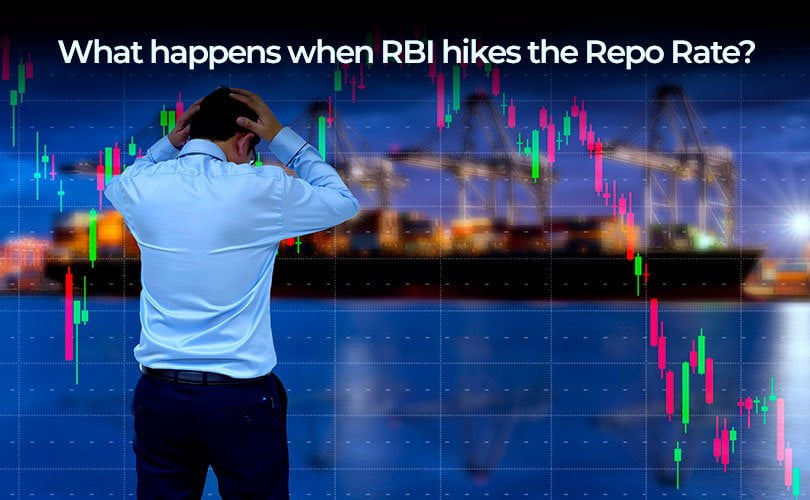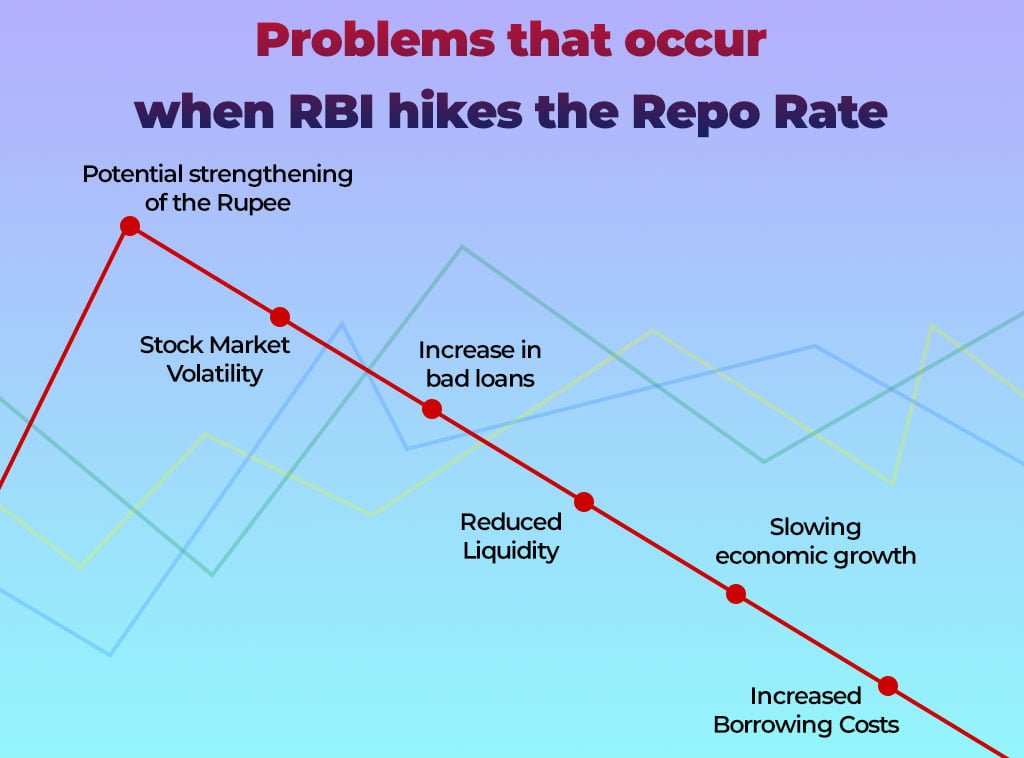

There was trouble in the air recently, as RBI hikes the repo rate. This led to causing problems for various sectors.
Repo rate in India is the basically the rate at which the Reserve Bank of India (RBI) lends money to the commercial banks in the company. As of September 2021, the repo rate was 4.00%. But the repo rate is subject to change, depending on the monetary policy decisions of the RBI.
The Repo Rate is a critical policy tool that the RBI uses, to control the inflation and to manage the monetary policy of the country. Repo rate has a direct impact on the economy.
There are different affects to the different stakeholders which includes the government, businesses and consumers. RBI uses the repo rate to properly control the money supply in the economy. When the RBI hikes the repo rate, it becomes expensive for the commercial banks to borrow money from the RBI.
This will result in commercial banks are less likely to borrow money and are likely to lend less money to their customers. This will lead to a decrease in the money supply. This also in turn, reduces the inflationary pressure which is there in the economy.
But, on the other hand, when the RBI decreases the repo rate, it becomes cheaper for commercial banks to borrow money. In the end, as a result, the banks are more likely to lend money, which increases the money supply, leading to higher inflation.
The repo rate has a direct impact on the cost of borrowing for both lenders and borrowers. When RBI increases the repo rate, commercial banks will have to pay higher interest rates, to borrow from the central bank, making it expensive for them to borrow money.
This, in turn, leads to higher lending rates for borrowers, making it more expensive for them to take loans. On the other hand, when the RBI decreases the repo rate, it becomes cheaper for banks to borrow money, leading to lower lending rates for borrowers.
The impact that the repo rate has on businesses, especially those that rely on borrowing to finance their operations. An increase in the repo rate leads to higher borrowing costs, which can hurt businesses’ profitability.
This can also lead to a decrease in investments and hiring, ultimately, hurting the economic growth. When the repo rate is decreased, it will lead to lowering the borrowing costs, which can stimulate investment and hiring and boost the economic growth.
When the repo rate increases, the corporations have to cut back on investment which is meant for expansion which results in a drop in the growth.
It also has an impact on the earnings and future cash flows, which culminates in a drop in stock values.
When RBI hikes the repo rate, it impacts the consumers as commercial banks increase their lending rates, which makes the borrowing more expensive for consumers. This can lead to higher rate of interests on loans such as home loans, car loans and personal loans, making it more expensive for consumers to borrow money.
Whereas, when the repo rate decreases, borrowing becomes cheaper, which leads to lower interest rates on loans and making it easier for consumers to borrow money.
The hike in the repo rate affects the government’s finances as well. When the RBI increases the repo rate, the borrowing costs for the government become higher which increases the fiscal deficit. This will, in turn, lead to a decrease in government spending on various programs and initiatives.
When there is a decrease in the repo rate, the borrowing costs become lower for the government, leading to a decrease in the fiscal deficit and allowing the government to spend more money on programs and initiatives.
When there is a certain change, there will be repercussions.
Currently, in the year 2023, big chaos got created when RBI hiked the repo rate. The current repo rate is 6.50%. This was increased by 25 base points which was announced by the Monetary Policy Committee (MPC) on the 8th of February. Earlier the repo rate was 6.25%. But, the reverse repo rate remained unchanged and is 3.35%.
But, there was a change in the Bank Rate and Marginal Standing Facility (MSF) as it became 6.75%. And finally, the Standing Deposit Facility rate is 6.25%.
The repo rate in India is set by the Reserve Bank of India (RBI) is basically calculated as the rate at which the central bank lends the money to the commercial banks for a short-term period.
The repo rate is determined by various economic factors and the monetary policy of the RBI, which is aimed at maintaining price stability and promoting economic growth.
After the repo rate was increased by the RBI in 2023, it had its after effects which created a riff. Here are certain problems that were caused when the RBI hiked the repo rate

The hike in the repo rate will increase the borrowing costs for individuals, businesses and the government, making it harder for them to access credit.
Having higher borrowing costs can lead to a decrease in consumer spending and business investment, which can slow down economic growth.
Hiking the repo rate can lead to a reduction in liquidity in the financial system, which can impact the ability of banks to lend and borrow money.
The increase in borrowing costs can make it difficult for the borrowers to repay their loans, which can result in an increase in bad loans and non-performing assets.
When there is a hike in the repo rate, it will lead to a stock market volatility as investors may become more risk-averse and pull their investments out of the market.
When there an increase in the repo rate, it will make the export more expensive and decrease competitiveness of Indian businesses in the global market.
In conclusion, when the RBI hikes the repo rate, it can impact various factors such as the borrowing costs, inflation, exchange rates, stock market and economic growth. The decision to hike the repo rate is taken by the RBI to control inflation and to maintain economic stability. However, it can also have a dampening effect on economic growth as higher interest rates can discourage investment and borrowing.





